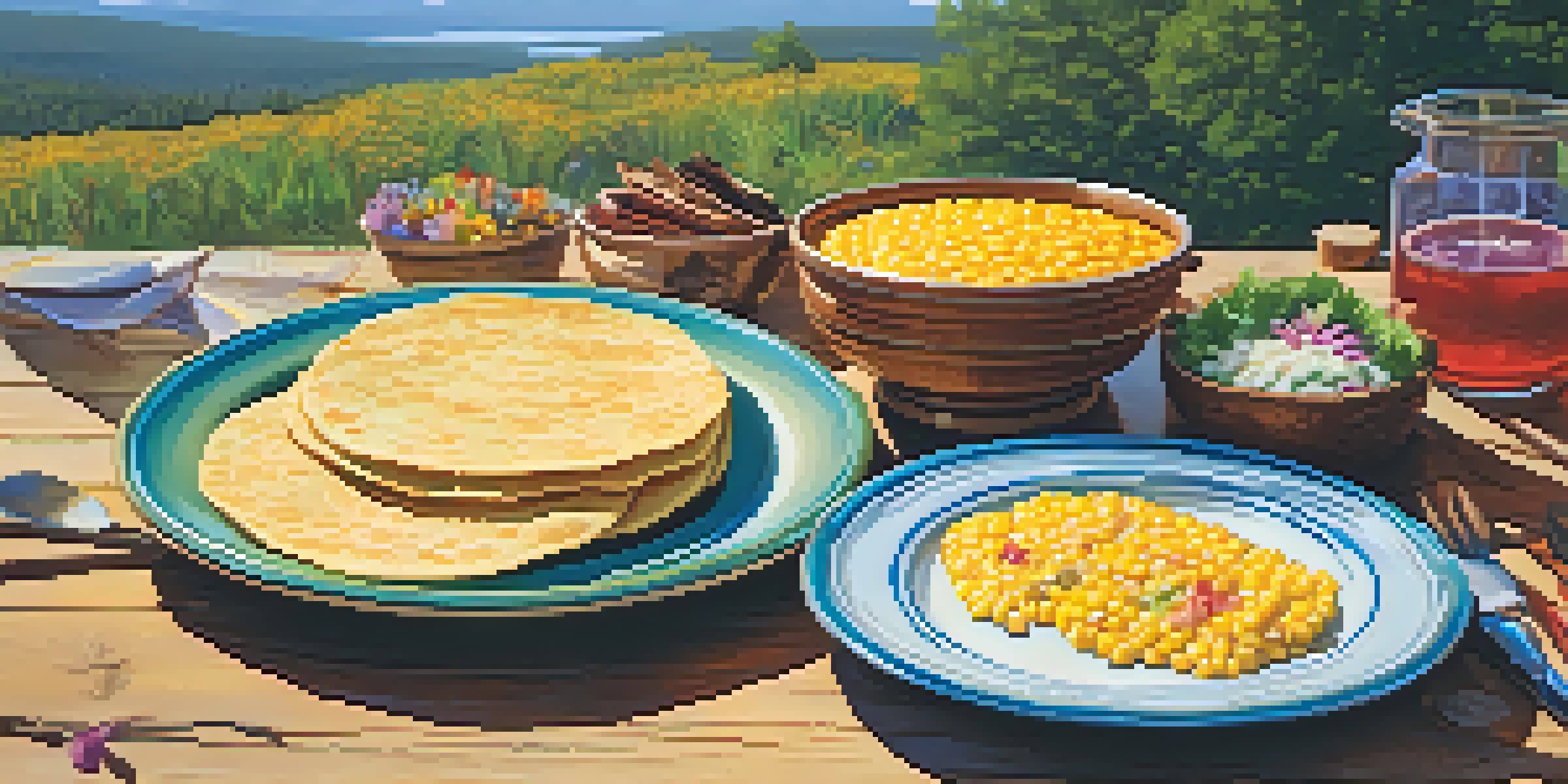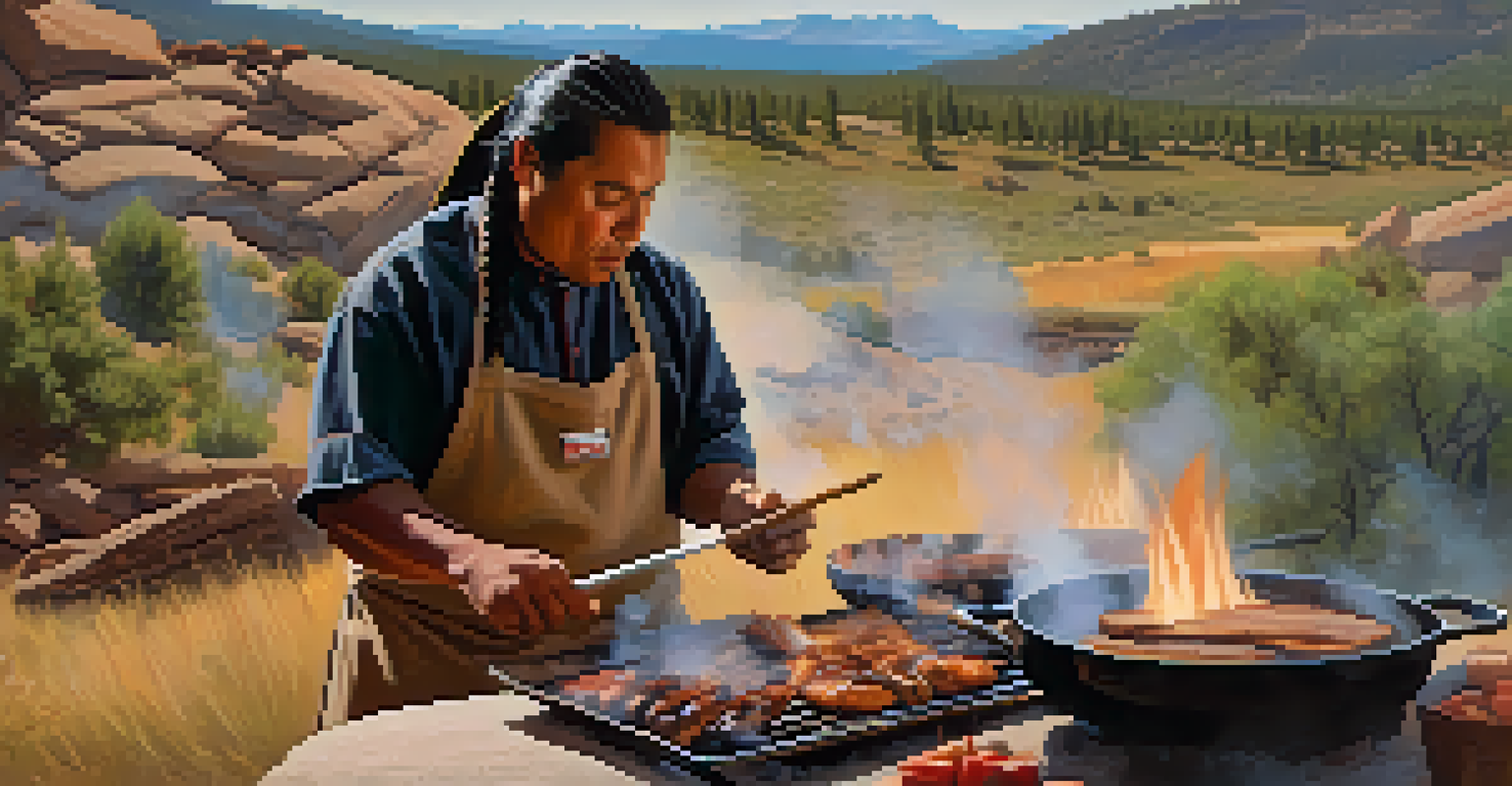The Influence of Native American Cuisine on Colorado Foods

Understanding Native American Culinary Heritage
Native American cuisine is rich and diverse, reflecting the various tribes and their unique environments. Ingredients like corn, beans, and squash, often referred to as the 'Three Sisters,' are staples in many Native dishes. These ingredients not only provide sustenance but also embody cultural significance and traditional farming practices that have been passed down through generations.
Food is our common ground, a universal experience.
In Colorado, the influence of local tribes, such as the Ute and Cheyenne, can be seen in the types of foods that are celebrated and preserved today. Traditional cooking methods, including open-fire roasting and stone boiling, are still practiced, showcasing a connection to the land and its resources. This heritage not only enriches the culinary landscape but also fosters a deeper appreciation for indigenous cultures.
Moreover, modern chefs in Colorado are increasingly incorporating Native American ingredients and techniques into their menus. By doing so, they pay homage to the rich history and traditions of the indigenous peoples while also offering diners a unique culinary experience that reflects the state’s diverse cultural tapestry.
Key Ingredients of Native American Cuisine in Colorado
In Colorado, several key ingredients are pivotal to Native American cooking, with corn often taking center stage. It’s used in various forms, from traditional tortillas to dishes like corn pudding. This versatile grain not only serves as a staple but also connects meals to historical and cultural narratives.

Another essential ingredient is wild game, which has been a source of nutrition for many tribes. Bison, elk, and venison are not just food items; they represent a deep respect for nature and the ecosystems that support these animals. In contemporary Colorado cuisine, chefs are embracing these meats, celebrating their flavors while promoting sustainable practices.
Culinary Heritage of Native Americans
Native American cuisine in Colorado showcases a rich diversity of ingredients and traditional cooking methods that reflect the cultural significance and ecological wisdom of indigenous peoples.
Fruits and vegetables, such as chokecherries, serviceberries, and various wild greens, also play a crucial role. These ingredients reflect the seasonal availability of local produce and are often used in traditional recipes, highlighting the importance of foraging and local agriculture in Native American culture.
Traditional Cooking Methods and Their Revival
Traditional cooking methods are integral to Native American cuisine, and they have seen a revival in many Colorado kitchens. Techniques like roasting meats over an open flame or using stone ovens are not just about cooking; they carry cultural significance and a sense of community. These methods evoke memories of gatherings and shared meals, reinforcing social bonds.
Cooking is like love. It should be entered into with abandon or not at all.
The resurgence of these practices can be attributed to a growing interest in authenticity and sustainability within the culinary world. Chefs are not just looking to recreate flavors; they are also exploring the stories behind the food. This approach encourages diners to connect with their meals on a deeper level, making dining more than just a sensory experience.
As a result, many restaurants and food festivals in Colorado are celebrating these traditional methods, offering workshops and demonstrations. This not only educates the public about Native American cuisine but also supports local chefs in their mission to honor indigenous practices and ingredients.
Influence on Modern Colorado Cuisine
The influence of Native American cuisine extends far beyond traditional dishes, impacting modern Colorado cuisine in various ways. Many chefs are blending indigenous ingredients with contemporary techniques, creating innovative dishes that pay tribute to the past while appealing to modern palates. This fusion often leads to exciting culinary experiences that surprise and delight diners.
For instance, you might find a bison burger topped with chokecherry barbecue sauce or a corn-based polenta served with seasonal vegetables. These dishes not only showcase local flavors but also highlight the importance of storytelling through food. By incorporating Native American elements, chefs are helping to keep these culinary traditions alive.
Modern Influence on Colorado Cuisine
Contemporary chefs in Colorado are creatively blending indigenous ingredients with modern techniques, offering unique dining experiences that honor Native American culinary traditions.
Moreover, this evolution of cuisine encourages a dialogue about food sovereignty and cultural identity. It invites diners to consider the origins of their food and respect the traditions that have shaped the culinary landscape of Colorado.
Celebrating Native American Food Festivals
Food festivals celebrating Native American cuisine are a fantastic way to experience this rich culinary heritage. Events like the Denver Indian Market & Art Expo showcase not only traditional foods but also the artistry and culture of Native American communities. These festivals provide a space for indigenous chefs to share their culinary skills and narratives with a broader audience.
Attendees can enjoy a variety of dishes, from fry bread to smoked salmon, each crafted with care and steeped in tradition. These gatherings also foster community, allowing for connections between Native and non-Native attendees, all united by a love for good food and cultural appreciation.
Additionally, these festivals often include cooking demonstrations and workshops, providing insight into traditional cooking methods and ingredients. This educational aspect encourages participants to explore Native American cuisine beyond the festival, inspiring them to incorporate these flavors and practices into their own cooking.
The Role of Education in Preserving Culinary Traditions
Education plays a vital role in preserving the culinary traditions of Native American cuisine, especially in Colorado. Schools and community programs increasingly incorporate indigenous foods and cooking methods into their curriculums. By teaching young people about their heritage, these programs help ensure that traditional practices continue for generations to come.
Moreover, partnerships between Native American chefs and local culinary schools are becoming more common. These collaborations not only elevate the profile of indigenous cuisine but also provide aspiring chefs with valuable knowledge about the cultural significance of the dishes they prepare. This exchange of ideas fosters a greater understanding and respect for Native American culinary traditions.
Education Preserves Culinary Traditions
Educational initiatives are vital in passing down Native American culinary practices, ensuring that future generations appreciate and continue these rich traditions.
Through workshops and cooking classes, participants can learn how to prepare traditional dishes while also gaining insight into the stories behind them. This educational approach empowers individuals to appreciate the rich tapestry of Native American cuisine and encourages them to share this knowledge with others.
Future of Native American Cuisine in Colorado
The future of Native American cuisine in Colorado looks promising, with increasing interest from both chefs and diners. As more people recognize the importance of supporting local and indigenous food systems, there is a growing demand for authentic Native American dishes. This trend not only benefits the culinary community but also helps to preserve the cultural heritage associated with these foods.
Additionally, as sustainability becomes a priority in the culinary world, Native American practices are gaining recognition for their ecological wisdom. Many indigenous cooking methods emphasize respect for the land and its resources, aligning well with modern sustainability principles. This convergence of traditional knowledge and contemporary practices offers a pathway for future culinary innovation.

Ultimately, the continued exploration and celebration of Native American cuisine in Colorado will foster greater cultural appreciation and understanding. By embracing these culinary traditions, we can enrich our dining experiences while honoring the history and contributions of the indigenous peoples who have shaped the region's food landscape.